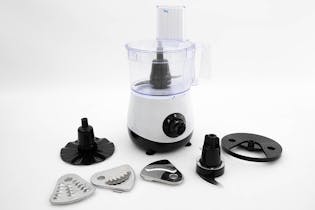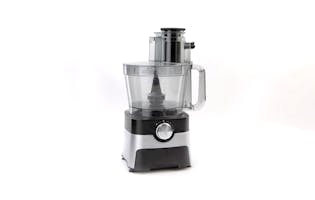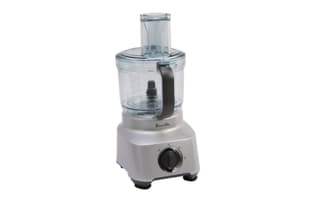Food processors
Find the best food processor for your home with our buying guide and test results for 19 new and 13 discontinued model.
Chop, slice, grate, blend, puree, mix and knead. A food processor is your jack of all trades in the kitchen.
Food processor functions
A processor should be equipped to deal with a variety of tasks, without breaking down or vibrating excessively.
Grating
Processors should be able to grate a range of foodstuffs well, without leaving ungrated lumps. You should be able to feed vegetables into the blender one by one.
Chopping
Most machines have an S-shaped steel blade for chopping. Chopped food should be even in texture with no large lumps.
Mixing
You should be able to make cake mixes, milkshakes and premix dough, without leaving lumps or unprocessed ingredients.
Pulse
A pulse function gives a short burst of power. It’s useful for distributing the load of a mixture and improving uniformity.

Features to consider
If you're thinking of buying a food processor, here's what to consider.
- Bowl capacity: Will you use your food processor to shred cabbage for a crowd? Or to chop up small amounts of nuts and herbs? Most food processors come with a bowl that holds between 1.5 and 4 litres of solid food (the maximum capacity for liquids is usually less because the liquid can leak out). Extra processing bowls in a range of sizes make a processor more versatile.
- Size: Consider how much bench or storage space you have and how frequently you will use the processor. Heavier models are best left on the bench, particularly if used often. A lighter compact unit is easier to handle (and takes up less cupboard space) if you need to put it away after each use.
- Bowl size: A larger bowl means you will be able to make bigger batches. But they will be more awkward to clean in the sink and may not fit in the dishwasher. Some models come with different sized bowls so you can pick the be size depending on what you’re processing.
- Rubber feet on the motor unit provide stability during operation.
- Heavy motor unit helps keep the unit stable on the bench during processing.
- Double feed-chute allows you to guide smaller/thinner foods into the food processor – so it provides better control in slicing/shredding.
- Reversible blades (such as a grating blade on 1 side and a slicing blade on the other) reduce the amount of storage space required.
- A range of blades give you more options for slicing and grating.
- Storage – whether it’s onboard or in a separate container, storage helps keep all the attachments together and protects the blades and attachments.
- Dishwasher safe attachments and bowls make cleaning easy.
-
Integrated scales are useful when you are adding ingredients. It’s best to leave the food processor in one spot on the bench and minimise movement. This prevents damaging the scales.
What about a mini food processor?
Like full-sized processors, mini food processors can process soft and hard foods – such as vegetables, hard cheese and breadcrumbs. Some models have small feed chutes for adding liquids when you’re making mayonnaise and salad dressings. They're also handy for making pesto and curry paste – a task some food processors can’t do unless they come with a mini processor attachment.
But mini processors are less versatile than their full-sized counterparts. They only have a capacity up to a litre (some are as little as 500ml) and only have a maximum processing time of up to 1 minute. They don’t usually have slicing, grating or shredding blades and can’t knead dough or pastry.

Before you rush out and buy one, consider what you’ve already got in your cupboard: many hand-held blenders come with a processor attachment.

People's Choice
Our People's Choice awards are granted to brands that consistently rate above average for customer satisfaction and meet out other performance criteria. Become a member and see which brands have earned a People’s Choice award.
Extra accessories
Food processors come with a range of accessories, but the following are also useful.
- Beater/whisk attachment: for whipping cream and beating egg whites.
- Citrus press: for oranges, grapefruit and so on.
-
Centrifugal juicer: for other (non-citrus) fruits and vegetables. Uses centrifugal force to push fruit and vegetables onto the blades to pulverise them quickly. This results in a frothier juice.
- Chipping disc blade: for making chips and vegetable strips.
- Mini processor bowl: sits inside the main food processor bowl and is great for processing small quantities such as nuts, and for making pesto and mayonnaise. A grinder attachment will do a similar job on coffee, spices, and dried herbs.
- Blender attachment: for smoothies, soups and milkshakes.
Think about how many extras you will actually use. Consider the other appliances already in your kitchen – if you already have a standalone blender there's little point in getting a food processor with a blender attachment.
Which brand is most reliable?
Get access to Consumer to view this premium content
- Thousands of expert product/service reviews
- Personal support through our Consumer Rights Advice Line
- Premium articles and in-depth buying advice
- Add a Consumer magazine for even more exclusive content
We've tested 32 food processors.
Find the right one for you.


